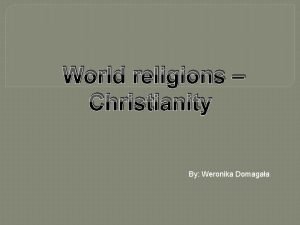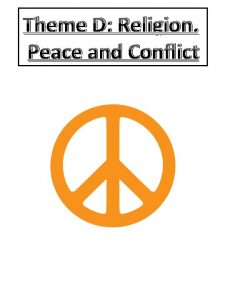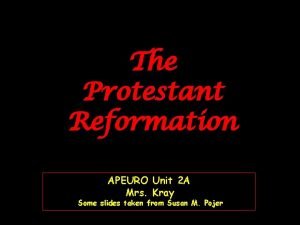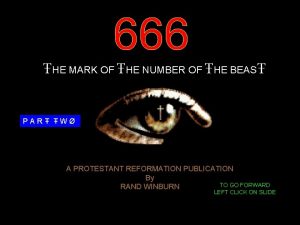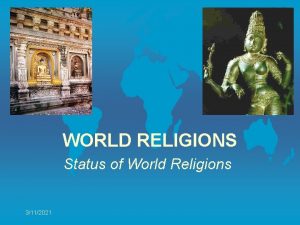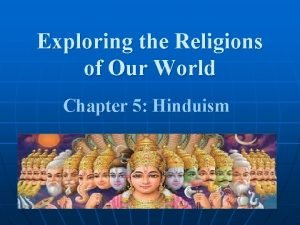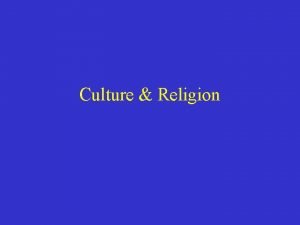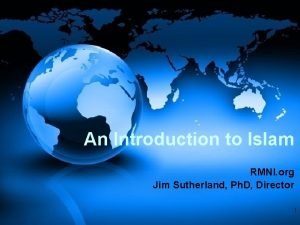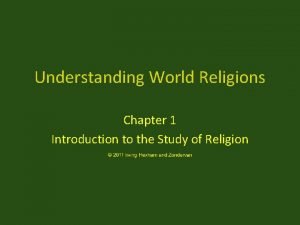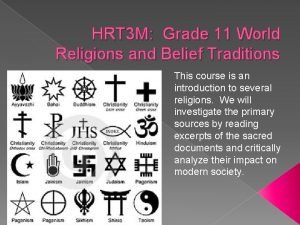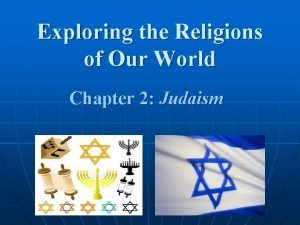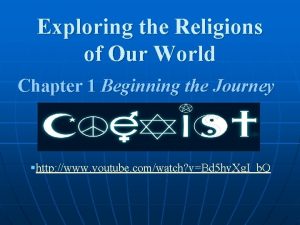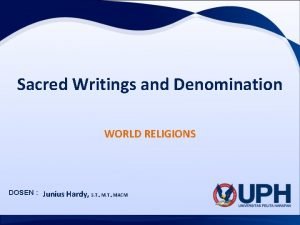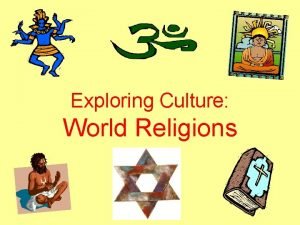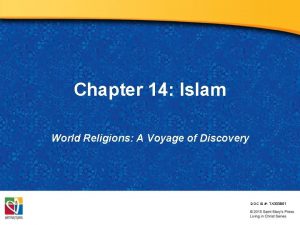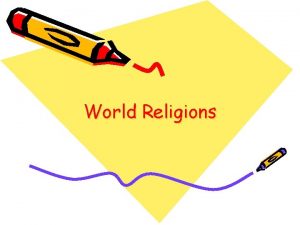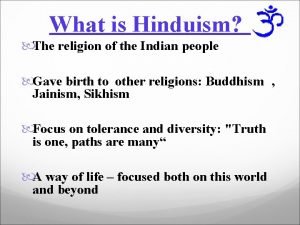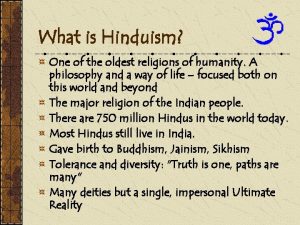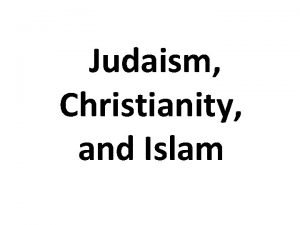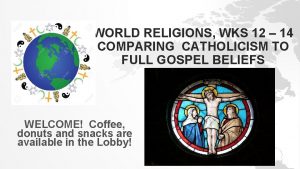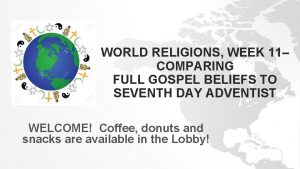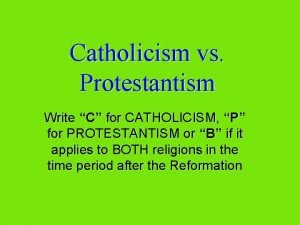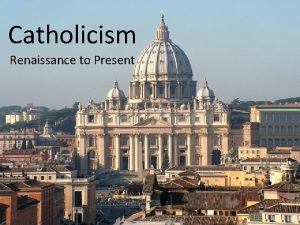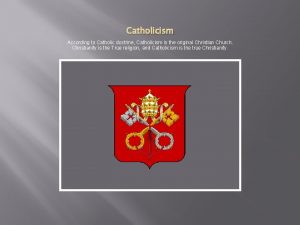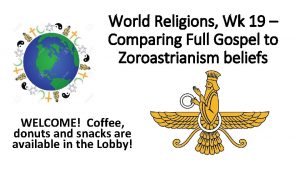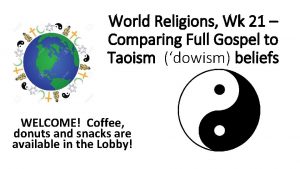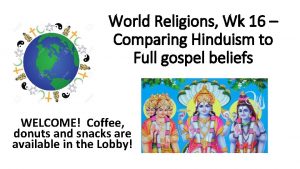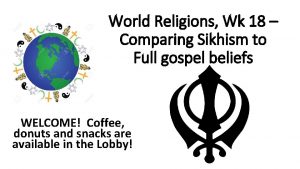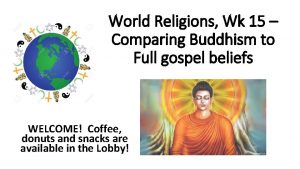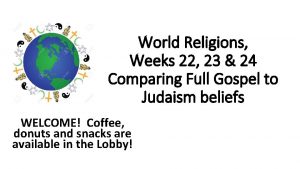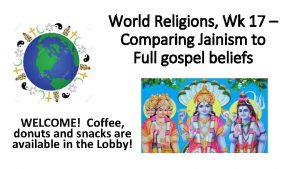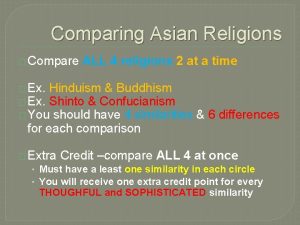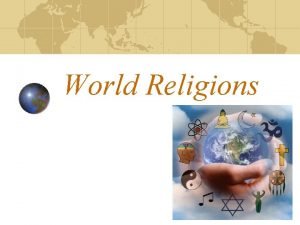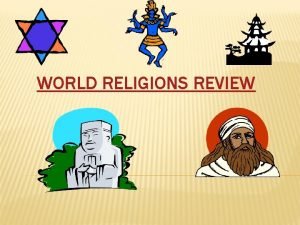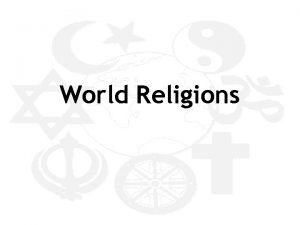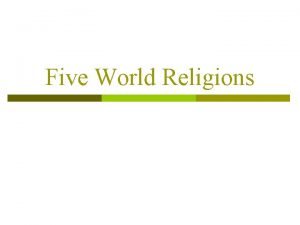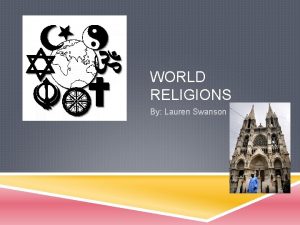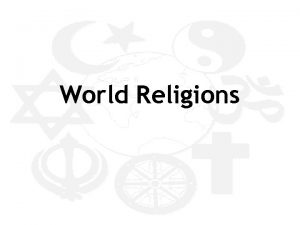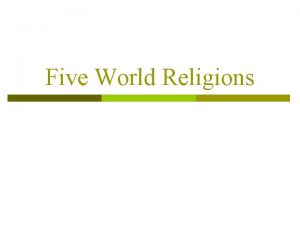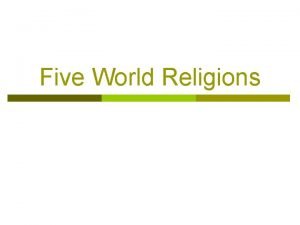WORLD RELIGIONS WEEK 12 COMPARING CATHOLICISM TO FULL

























- Slides: 25

WORLD RELIGIONS, WEEK 12 – COMPARING CATHOLICISM TO FULL GOSPEL BELIEFS WELCOME! Coffee, donuts and snacks are available in the Lobby!

CENTRAL TENET OF THIS COURSE: The 66 Book Holy Bible(KJV, or NIV) is the inerrant Word of God, written by 40 different men over a span of 1, 500 years, inspired by God, and ascribe as Canon by bible scholars at the 1 st Council of Carthage, 397 AD, and has remained virtually unchanged for over the past 1, 700 years. • • Per the AG Position Papers: “The Scriptures, both the Old and New Testaments, are verbally inspired of God and are the revelation of God to man, the infallible, authoritative rule of faith and conduct: ” • • (2 Timothy 3: 15 -17; 1 Thessalonians 2: 13; 2 Peter 1: 21)” (KJV). 1 • The referenced books (see References page: ) are considered accurate, and up to date.

BASIC BELIEFS MARTIN LUTHER’S 5 SOLAS Salvation is given by: 1. By grace alone, 2. By Christ alone 3. by faith alone, 4. By Scripture alone, 5. Glory to God alone. • FOUR AG CORE BELIEFS 1. Salvation 2. Baptism in the Holy Spirit 3. Divine Healing 4. The 2 nd Coming of Christ.

AG’S 16 “FUNDAMENTAL TRUTHS” 1. The Scriptures Inspired 9. Sanctification 2. The One True God 3. The Deity of the Lord Jesus Christ 10. The Church and Its Mission 4. The Fall of Man 12. Divine Healing 5. The Salvation of Man 13. The Blessed Hope 6. The Ordinances of the Church 14. The Millennial Reign of Christ 7. The Baptism in the Holy Spirit 15. The Final Judgment 8. The Initial Physical Evidence of the Baptism in the Holy Spirit COPYRIGHT BY DAVID BONILLA, OCTOBER 2017 11. The Ministry 16. The New Heavens and the New Earth

WHAT DO OUR CHURCH’S BY-LAWS SAY? • ARTICLE SIX – TENETS OF FAITH • As Tenets of Faith, this church accepts the Holy Bible as the inspired and revealed Will of God, the all sufficient rule of faith and practice , and for the purpose of maintaining general unity, adopts the Statement of fundamental truths approved by the General Council, as same is now and from time to time may be revised, and as recited in the true copy thereof which follows as an addendum to this code of Constitution and Bylaws, by this reference incorporated herein as through set forth in full.

FIRST, A FEW QUESTIONS • What does “anabaptist” mean? • How may of you have been Catholic before? • Do you have other family member who are Catholic? • What do you say to each other concerning religion?

CATHOLICISM HISTORY - I • They are considered Christian. Why? Because they believe in Jesus Christ, the Holy Spirit and God of course: The Trinity, and the Bible • Largest Christian population in the world today: 1. 3 Billion in 2017 • This church [religion] has been the decisive spiritual force in the history of Western civilization. Along with Eastern Orthodoxy and Protestantism, it is one of the three major branches of Christianity. • I give them CREDIT for keeping the Bible alive; laboriously copied, but not rewritten, nor modified. • But, there are some major “black eyes: in their history! • The Crusades • The Inquisitions (later)

HISTORY – II THE INQUISITIONS • The Inquisition was a powerful office set up within the Catholic Church to root out and punish heresy throughout Europe and the Americas. • Beginning in the 12 th century and continuing for hundreds of years, the Inquisition is infamous for the severity of its tortures and its persecution of Jews and Muslims. • Its worst manifestation was in Spain, where the Spanish Inquisition was a dominant force for more than 200 years, resulting in some 32, 000 executions

HISTORY - III • Traces its history to Jesus Christ and the Apostles. It has developed a highly sophisticated theology and an elaborate organizational structure headed by the papacy, the oldest continuing absolute monarchy in the world. • Moved beyond the geographic borders of Judaism, as the dramatic sentence (Acts 28: 14) of the closing chapter of Acts announces: “And thus we came to Rome” • The Church at Rome, later develop into as Roman Catholicism, was started in the apostolic times (circa AD 30 -95). (Gingerich) • But, from 1 st century to 313 AD, Christians worshipped in homes, caves, hiding, and persecuted

HISTORY - IV • Roman Emperor Constantine professed a conversion to Christianity in AD 312. • He issued the Edict of Milan in 313, which granted freedom of worship throughout the empire. Made Christianity legal. Gave pagan temples to the Christians • He began to make changes that ultimately led to the formation of the Roman Catholic Church. • NOTE: Roman Catholic Bibles contain all the books one would find in Protestant editions. However, Catholicism also recognizes the collection of 15 books called the Apocrypha to be within the canon of Holy Scripture. (Gingerich)

HISTORY - V • The Apostolic authority formulated by the bishop of Lyon, St. Irenaeus (130– 200 AD), identifies the three main sources of authority for Catholics: 1. 2. 3. • the Scriptures of the New Testament (alongside the Hebrew Scriptures, or “Old Testament, ” which Christians interpret as prophesying the coming of Jesus); the episcopal centers established by the Apostles as the seats of their identifiable successors in the governance of the church (traditionally at Alexandria, Antioch, Jerusalem, and Rome the apostolic tradition of normative doctrine as the “rule of faith” and the standard of Christian conduct. The charter of the Roman Catholic Church: “And so I say to you, you are Peter, and upon this rock [Greek petra] I will build my church, and the gates of the netherworld shall not prevail against it. I will give you the keys to the kingdom of heaven. Whatever you bind on earth shall be bound in heaven; and whatever you loose on earth shall be loosed in heaven. (Matthew 16: 18– 19)

HISTORY – VI THE GREAT SCHISM OF 1054 • The Church was split in two by the Great Schism of 1054, dividing Christians between the western, Latin-speaking Roman Catholic Church and the eastern, Greek-speaking Eastern Orthodox Church. • This schism was over two main doctrinal disagreements. One was obviously the role and authority of the Pope. The other was a clause of the Nicene Creed. • The western Catholics believe that the Holy Spirit proceeds from the Father and the Son while the Eastern Orthodox believe that the Holy Spirit proceeds only from the Father. (Gingerich)

HISTORY – VII TWO MORE GREAT SPLITS • 1517 – The Reformation. Augustin Monk, Martin Luther’s, 95 Thesis Protestation. His followers became known as “Protestants. ” • The Anglican Church: When King Henry VIII split from the Roman Catholic Church in 1534, when the pope refused to grant the king an annulment. • Today, the Anglican Communion represents over 85 million people in over 165 countries. • PAPAL HISTORY: • According to the Annuario Pontificio, the papal annual, there have been more than 260 popes since St. Peter, traditionally considered the first pope.

LET’S RETRACE ASSEMBLIES OF GOD BELIEFS • Four Core Beliefs • 16 Fundamental Truths • Two Ordinances (aka sacraments in Catholicism) • Official AG Position papers • Presbyterian style church government; modified by CA Corporation law, and IRS: church is lead by the Eldership/Pastor(s), who are supported by the Deacons/Directors. The church body may have limited say into the major decisions of the church, but those who meet the biblical qualifications for leadership share the weight of governance and power.

COMPARISON OF SACRAMENTS 7 CATHOLIC SACRAMENTS (RE MANNING, P 81) 2 AG ORDINANCES/SACRAMENTS 1. Baptism: Child, by sprinkling 1. Baptism: Adult, Full Immersion 2. Confirmation conferred on the faithful (about 7 YO), 2. Communion: Periodic by believers 3. Communion, at about 7 YO 4. Marriage 5. Ordination if deacons & priests 6. Holy Communion, annually 7. Last Rites; before death

CATHOLIC BELIEFS - I • Roman Catholic Church is the one true church • Church Tradition and Bible coexist • Child Baptisms • Holy Communion annually • Believe in Purgatory • Pray to Christ or any variety of saints, • Celibate priests • Private oral sin confession to a priest annually

CATHOLIC BELIEFS - II • Transubstantiation of the Eucharist (elements of the communion) • Basis and justification for the practice of Adoration of the Elements • Immaculate conception of the Virgin Mary and her bodily Assumption. • Catechism (CCC, last revised 1992) • Papal infallibility: official since 1870. • Abortion, and artificial contraception, are both forbidden • Distinction between Mortal and Venial sins.

CATHOLIC BELIEFS - III • Salvation is attained by cooperating with grace through faith, good works, and participation in the sacraments. • Final salvation depends on the state of the soul at death. As Jesus himself tells us, “He who endures to the end will be saved” (Matt. 24: 13; cf. 25: 31– 46). • The Bible: Evangelicals use the Bible as a rule book. Catholics use it as a prayer book. • Although in Mexico, it was forbidden for lay persons to read the Bible. • Latin is still used in Mass Rites today. They say that “everyone understands Latin. ”

CATHOLIC BELIEFS - IV • Purgatory as a process of cleansing that dates back to early • It was the heyday of medieval otherworld-journey narratives such as the Irish Visio Tnugdali, and of pilgrims' tales about St. Patrick's Purgatory, a cave like entrance to purgatory on a remote island in Ireland. • Purgatory has two purposes: • a temporal punishment for sin, and • the cleansing from the attachment to sin. • Purgatory purifies the soul before the soul's grand entrance into heaven. Christianity in the 12 th century

STATISTICS - I • Catholics church has a very “flat, ” Top Down organization: Pope, cardinals, archbishops, priests, deacons, parishes, archdioceses, and dioceses, • But, each diocese is a separately incorporated entity with no formal linkages between the different diocese or the Vatican. • Whopping statistics! • Largest Christian population in the world today: 1. 3 Billion in 2017 • About 51 million Catholic adults in the U. S. The share of Americans who are Catholic declined from 24% in 2007 to 21% in 2014. • Catholicism has experienced a greater net loss due to religious switching than has any other religious tradition in the U. S Take a look!

STATISTICS -II • Catholics in the U. S. are racially and ethnically diverse • Catholics are fairly evenly dispersed throughout the country • Many U. S. Catholics say they want to see the church make significant changes. • Politically, Catholic registered voters are evenly split between those who identify with or lean toward the Democratic Party (47%) and those who favor the GOP (46%). • Large majorities of U. S. Catholics have admired Pope Francis throughout his tenure, but there are growing signs of discontent

OTHER STATISTICS - III • The Catholic Church—mostly hospitals and educational institutions—spent $170 billion in the United States alone back in 2010. • The Vatican Bank alone has $8 billion in assets in Italy (it is a tax haven. ) • FYI, There are three Catholic Churches in Merced • Any questions?

THIS IS IT FOR TODAY • God be with you •

REFERENCES - I (FOR THIS LESSON ONLY) • Garcia, Ehiza, Vatican, Inc. (2015) retrieved September 20, 2019 from, https: //money. cnn. com/2015/09/24/news/pope-francis-visitvatican-catholic-church/index. html • Gingerich, Barton ( Anglican Pastor), retrieved September 20, 2019, from https: //www. christianity. com/church/denominations/whatis-catholicism. html • Pelikan, Jaroslav Jan; et al, retrieved September 20, 2019 from https: //www. britannica. com/topic/Roman-Catholicism

REFERENCES - II • 7 Facts about American Catholics, retrieved September 20 , 2019, from https: //www. pewresearch. org/facttank/2018/10/10/7 -facts-about-american-catholics/ • Re Manning, et al, 30 Second Religion, the 50 Most Thought Provoking Beliefs; each explained in half a minute, Metro Books NY, 2011
 Branches of catholicism
Branches of catholicism Branches of catholic church
Branches of catholic church Christianity branches
Christianity branches Who was the greatest supporter of militant catholicism
Who was the greatest supporter of militant catholicism Christianity vs catholicism
Christianity vs catholicism Protestant vs lutheran
Protestant vs lutheran Difference between catholic and christian
Difference between catholic and christian Mark of the beas
Mark of the beas World religion map 2021
World religion map 2021 Exploring the religions of our world pdf
Exploring the religions of our world pdf Religion and geography
Religion and geography Major branches
Major branches World religions chapter 1
World religions chapter 1 Grade 11 world religions
Grade 11 world religions Religion
Religion Exploring the religions of our world chapter 1 pdf
Exploring the religions of our world chapter 1 pdf Which cultures believe in reincarnation
Which cultures believe in reincarnation Religions in the world
Religions in the world Religion
Religion Religions of the world
Religions of the world Religions of the world
Religions of the world Religion
Religion World oldest religion
World oldest religion Steyning primary school uniform
Steyning primary school uniform Religions of the world
Religions of the world Judaism location
Judaism location
